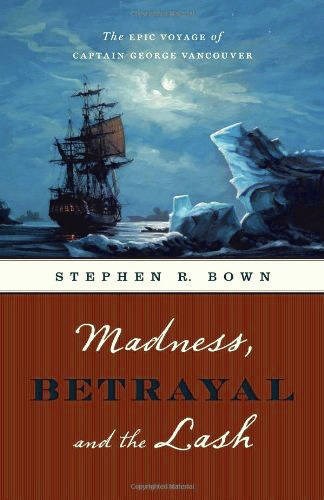Last week, I discussed an interesting book about Captain Vancouver that looked at the diseases on board ships in the 1700s, the lashings and the poor captain’s humiliation back in England.
Madness, Betrayal and the Lash by Stephen R. Brown (2008, Douglas and McIntyre Ltd.) is a fascinating account of Vancouver’s life and discoveries, especially the intriguing chapter titled A Meeting of Minds, which addresses the cautious communication between Vancouver, Juan Francisco de la Bodega y Quadra — the Peruvian-born commander of the Spanish Pacific fleet (out of Mexico) — and First Nations chief Maquinna.
With great and perhaps strategic cultural aplomb and traditional dignity, the three met, negotiated, socialized and dined together — as well as sizing each other up — at Friendly Cove, Nootka Sound. Captain Vancouver was astonished to see the Spanish using silver plates and crystal glasses at this remote settlement!
Lurking in the background was a fellow named Archibald Menzies, a botanist and doctor on Vancouver’s ship. I say lurking, because throughout the book, although Captain Vancouver was the star, Menzies was always there in the background, and there was friction between the two right from the start.
Some of the tension was over the size and placement — on the quarterdeck — of Menzies’ plant-collection box, his “plant hutch.” At best, their relationship could be described as mutual tolerance.
However, the entire idea of botany classification and collecting specimens from around the world in the age of sea exploration is appealing to learn about.
There’s a lovely informative book on the topic, In Nature’s Realm, Early Naturalists Explore Vancouver Island by Michael Layland (2019, Touchwood Editions).
This book is large and brimming with information on British Columbia’s coastal past and horticultural endeavours, as well as being stunningly designed and illustrated – it’s like a coffee-table book, but with a vast amount of beautifully presented knowledge on both flora and fauna and historical discovery.
There is a chapter on Menzies and his observations, as well as a photograph of his “plant hutch” (a replica, as the original, although too old to have survived, was also heavily damaged in a storm at sea, ironically toward the end of Vancouver’s voyage. This replica can be seen at the VanDusen Botanical Garden in Vancouver).
Menzies and the crew saw a skunk and discovered the creature’s pungent defence mechanism. Experts say that today, there are no skunks on Vancouver Island, although there is a powerful skunk-like stench just north of Duncan and just north of Parksville; the odour is always present in those two locations. I used to think it was Archie in the back seat, relaxed and expelling a pong after eating some disgusting beach debris, and then I noticed that it was very similar to the pungent whiff of cannabis. But alas, it is no doubt a saturated bog of skunk cabbages.
Of course, there is an abundance of details on First Nation culture and plant usage in this lovely book, as well as numerous photographs and floral watercolours and drawings.
One amusing image is an 1890 photograph of members of the Natural History Society of B.C., a group of dapper lambchop-moustached men in top hats and bowlers with walking sticks, posed in what looks like a Garry oak wood in Cadboro Bay. There’s one little girl member as well. (I had to search for her.)
The Victoria Natural History Society of today has created a very lovely little book simply titled Nature Guide to the Victoria Region, edited by Ann Nightingale and Claudia Copley (2012, Royal B.C. Museum). It covers everything from dragonflies to lichens, marshes to tidal pools, grey wolves to shrews and male and female Douglas fir cones, and is full of coloured photographs, lists and observations, plus instructions on handling nature.
Lastly, if you enjoy trees and would like to learn about tree recognition as well as how trees interact within their ecosystems, take a look at Wild Trees of British Columbia by Sherman G. Brough (1998, Pacific Educational Press).
In it, you’ll discover that the Pacific Madrone - also known as Arbutus Menziesii for Archibald Menzies (although he was not the first to discover it) - is the only broad-leafed evergreen tree native to Canada and interacts with the varied thrush, the earwig and the pixie-cup lichen.
Its leaves, bark and roots have been used to cure the common cold and sore throat, something we all may need this rainy season.



